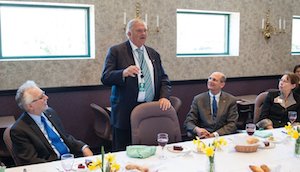The Seventh-day Adventist Church in Germany has published a statement pertaining to actions it took in the context of the outbreak of World War I. The Southern and Northern German Union Conferences of the Seventh-day Adventist church adopted the statement on April 6 and April 13, 2014 respectively, and published it the May edition of the Church magazine “Adventisten heute” (Adventist Today), under the title “Guilt and Failure”.
The Presidents of both Conferences, Pastors Johannes Naether (Hannover) and Günther Machel (Ostfildern near Stuttgart), recall that many Adventists at the time saw the outbreak of World War I as “a sign of the end of the world”. Before the war, a number of Adventists had served in the military but refused to carry out duties on Sabbath (Saturday), risking potentially severe penalties. Others considered it part of their preparation for the imminent return of Jesus to refuse to carry weapons or to participate in the military immunization program.
However, shortly after the general mobilization on August 2, 1914, the Central European leadership of the Seventh-day Adventist Church in Hamburg issued a circular letter recommending enlisted Adventists to “fulfil our military duties wholeheartedly and with joy," to bear arms, and also to serve on the Sabbath. This circular and other such publications provoked a complex protest in Adventist congregations, leading to tensions and divisions within the church. In 1915 this state of affairs led to the rising of a separate organization, the self-designated “Reform Movement”, which accused its mother church, the “greater church” of a “Babylonian apostasy from the true Advent faith”.
"Today we recognize and concede," said the two German Seventh-day Adventist leaders, "that during these disputes our fathers often did not act in the spirit of love and reconciliation demonstrated by Jesus." Out of concern for the survival of the denomination in Germany, advice contradicting the Word of God was given which led to division and profound hurt. The former Adventist leadership did not adequately fulfil their responsibility to the Church. They unjustly accused members who contradicted them of having “fallen” from the truth, and in individual cases went as far as having people pursued by the authorities.
During negotiations with the Reform Movement from June 21 to 23, 1920, in Friedensau, Germany, Pastor Arthur G. Daniells, President of the General Conference (World Church Leadership) of the Seventh-day Adventist Church, objected to the position of the German Church Leadership regarding military service and emphasized "We would not have made such a declaration." At the Pastors meeting, taking place immediately before the negotiations in Friedensau, those directly responsible for the documents had rescinded their statements as "erroneous" and on January 2, 1923 again expressed regret "that such documents had ever been released."
Today, Pastors Naether and Machel again apologize in the name of the Seventh-day Adventist Church, saying; "Even though none of those directly involved are still alive, we ask their descendants and relatives along with the still existing groups of the Reform Movement for forgiveness for our failings. From these painful experiences we have learned that the children of God are called to be people of peace, and to reject every form of violence against the innocent. We believe that disciples of Jesus are truest to the statements of the Holy Scriptures when they act as ambassadors for peace and reconciliation."
The two Church Leaders recall the "Declaration of Peace" of the former President of the General Conference, Pastor Neal C. Wilson, of June 1985: “In a world full of fighting and hatred, a world of ideological and military conflicts, Seventh-day Adventists want to be known as peacemakers, and want to advocate for global justice and peace under Christ as the head of a new humanity.”
The Adventist Reform Movement
As in August 1914 the First World War began and 3,000 of the 15,000 German Adventists were called up to military service, they came to different conclusions when considering how to behave in response to the crisis. While the majority followed the directive circulated by the Church Leadership and became fully-fledged military servicemen, critics of this decision clearly expressed their disapproval.
From amongst these critics, some of whom explained their opposition by their expectation of Jesus return in early summer 1915, a fixed group established itself over the course of the year. Some later found a place back in an Adventist congregation, but the majority of the objectors remained part of this “Seventh-day Adventist Reform Movement” which rejected any form of military service altogether.
The circular letter of August 2, 1914, was criticized by the Adventist Church World Leadership based in the USA, and was later withdrawn with regret by the German Church Leadership in 1920, and again in 1923. This attempt at reconciliation failed however, as had previous attempts from both sides soon after the First World War ended. As a result, two Adventist camps existed during the time of the Weimar Republic: the traditional Seventh-day Adventists, and the Reformed Seventh-day Adventists, who subsequently divided into a number of further smaller groups due to internal conflicts. Most dissolved prior to the start of the Nazi regime, and the remaining groups soon came to the attention of the new rulers, since they refused to participate in elections. In 1936 the Gestapo dissolved the Reform Movement. Most of the smaller groups were outlawed in the same year, the remainder in 1937 and 1942.
Today, the Seventh-day Adventist Church is comprised of more than 18 million adult baptized members around the world; in Germany there are around 35,000. The Reform Movement experienced a schism in 1951, and since then exists as two groups, each with about 30,000 members worldwide. In Germany, the "Seventh-day Adventist Church Reform Movement, International Missionary Society" (IMS) claims about 350 members. The "Seventh-day Adventist Reform Movement" (SDARM) is slightly smaller with about 200 members in Germany. More information on the Internet about the Seventh-day Adventist Reform Movement Organizations is available for SDARM at http://www.sdarm.org/ and for IMS at http://www.sda1844.org/. Informations about the Seventh-day Adventist Church at http://www.adventist.org



